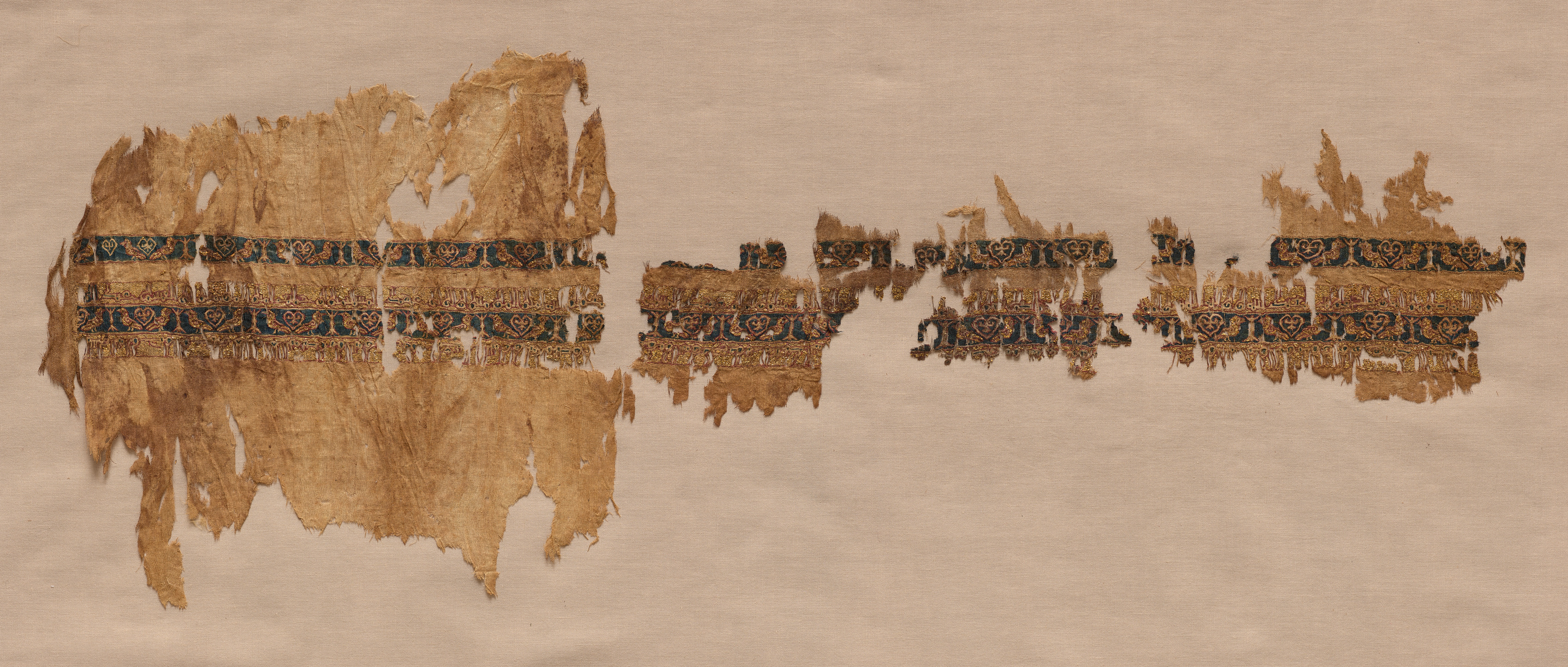The Cleveland Museum of Art
Collection Online as of April 19, 2024

Tiraz with gold, probably from a wide sleeve
1013–1020
Overall: 23.5 x 62.3 cm (9 1/4 x 24 1/2 in.)
John L. Severance Fund 1950.549
Location: not on view
Description
This textile with expensive gold foil is among the rarest surviving examples among thousands of medieval textiles with historic or generic inscriptions in Arabic, known as tiraz. Tiraz were "emblems of dignity," the prerogative of sovereigns and those they wished to honor. This inscription is masterful. The tall letters are woven with silk thread on only two warps in slit-tapestry weave while the ground was woven with pure gold foil wrapped around a silk core that was not beaten in—to show off its brilliance. The text begins with a prayer and provides the name of Imam al-Hakim, but lacks the place and date of manufacture. The decorative bands feature brilliant gold birds facing simplified trees alternating with popular palmette-decorated hearts. This tiraz fragment may have been part of a wide sleeve that functioned as a receptacle because clothing didn’t have pockets.- ?-1950(Dr. Emil Delmar [1876-1959], Budapest, Hungary, and New York, NY, sold to the Cleveland Museum of Art)
- Institut français d'archéologie orientale du Caire, Etienne Combe, Jean Sauvaget, et Gaston Wiet. Répertoire chronologique d'épigraphie arabe. Le Caire: Impr. de l'Institut français d'archéologie orientale, 1931. no. 2214Wadsworth Atheneum, Adelyn Dohme Breeskin, and Charles Crehore Cunningham. 2000 Years of Tapestry Weaving: A Loan Exhibition : Wadsworth Atheneum, Hartford, Dec. 7, 1951 to Jan. 27, 1952 ; the Baltimore Museum of Art, Feb. 27, 1952 to Mar. 25, 1952. Hartford, Conn: Wardsworth Atheneum], 1951. no. 56Mackie, Louise W. Symbols of Power: Luxury Textiles from Islamic Lands, 7th-21st Century. Cleveland; New Haven: Cleveland Museum of Art; Yale University Press, 2015. Reproduced: P. 99, fig. 3.14; Mentioned: P. 99, 215O'Kane, Bernard. "The Egyptian Art of the Tiraz in Fatimid Times." In The World of the Fatimids. Melikian-Chirvani, Assadullah Souren, ed. Toronto: Aga Khan Museum in association with The Institute of Ismaili Studies and Hirmer, 2018. Mentioned: pp. 182-183; Reproduced: p. 183McWilliams, Mary, and Jochen A. Sokoly. Social Fabrics: Inscribed Textiles from Medieval Egyptian Tombs. Cambridge, Mass. : Harvard Art Museums, 2021. Mentioned: p. 15, 55 and 97; Reproduced: p. 15, fig. 6, p. 55, fig. 7 and 8, and 96.
- Social Fabrics: Inscribed Textiles from Egyptian Tombs, 9th - 12th Century. Harvard Art Museums, Cambridge, MA (organizer) (January 22-May 8, 2022) https://harvardartmuseums.org/exhibitions/5836/social-fabrics-inscribed-textiles-from-medieval-egyptian-tombs.Islamic art rotation. The Cleveland Museum of Art, Cleveland, OH (organizer) (December 16, 2013-December 15, 2014).2000 Years of Tapestry Weaving. Wadsworth Atheneum, Hartford, CT (December 7, 1951-January 27, 1952); Baltimore Museum of Art, Baltimore, MD (February 27-March 25, 1952).
- {{cite web|title=Tiraz with gold, probably from a wide sleeve|url=false|author=|year=1013–1020|access-date=19 April 2024|publisher=Cleveland Museum of Art}}
Source URL:
https://www.clevelandart.org/art/1950.549